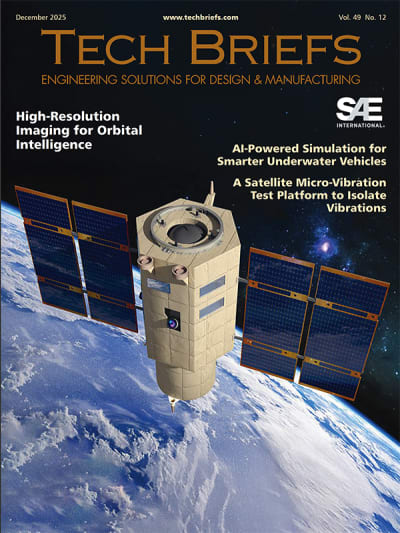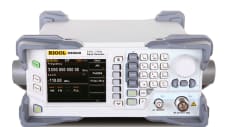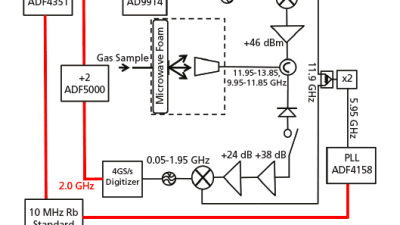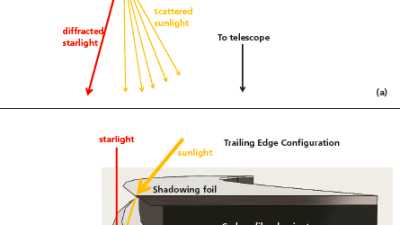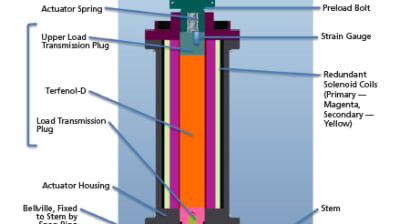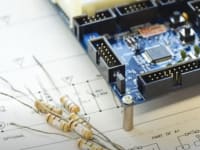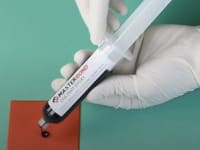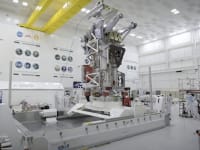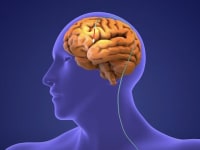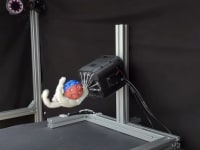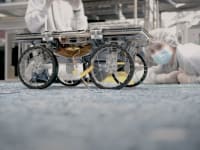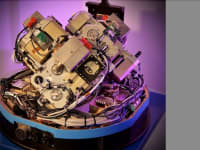Stories
61
0
9390
30
Briefs: Electronics & Computers
Radiation-Hardened, High-Voltage, Quad-Channel Amplifier
Aradiation-hard, 130-Volt, 100-KHz capable, quad-channel operational amplifier with corresponding power supply and 6th-order Bessel filter circuitry has been designed, fabricated, and successfully tested. To control two-axis microelectromechanical systems (MEMS)-based mirrors, a differential...
Products: Test & Measurement
Saelig Co. (Fairport, NY) announced Rigol DSG800 RF signal generators with output frequencies from 9 kHz to 3.0 GHz. They provide an RF signal source with a maximum output of +20 dBm and frequency resolution of 0.01 Hz at...
Briefs: Electronics & Computers
Microwave spectroscopy is an invaluable tool for studying the structure, dynamics, and even the handedness of gas phase species. In...
Briefs: Electronics & Computers
Signal Digitizer and Cross-Correlation ASIC
Microwave interferometry provides a means of synthesizing large scanning antennas that are not otherwise physically practical for spaceborne Earth observational systems. By cross-correlating multiple receivers of an array, high-resolution images are synthesized from a sparse — or thinned — array of...
Briefs: Electronics & Computers
Image Capture to Stereo Correlation in an FPGA
In this work, there were four independent vision modules implemented in an FPGA: a CameraLink camera interface, rectification, bilateral filtering, and stereo disparity correlation. Each module was originally designed to run from end to end, not in a pipeline with the other modules. This limited...
Briefs: Electronics & Computers
Constellations of low-cost, small instruments provide global, distributed, and frequent coverage, enabling unique science observations. However, radars are active instruments...
Briefs: Materials
Flexible, High-Temperature Polyimide/Urea Aerogels
Cross-linked silica-based aerogels with polymeric materials, as well as incorporating a flexible linkage into the underlying metal oxide, have been proven to improve strength and resilience over their native, or non-cross-linked, counterparts without adversely affecting porosity and density. In...
Briefs: Materials
Cryogenic fluid management (CFM) is a critical technical area that is needed for the successful development of future space exploration. A key challenge is the storability of LH2, LCH4, and LOX propellants for long...
Briefs: Materials
Colorimetric Indicator for Detection of AF-M315E
An easy and instant method of detection was needed for AF-M315E, a “green” propellant that produces very little vapor. This makes it hard to detect by smell or other active sensors.
Briefs: Materials
Oriented Nanofibers Embedded in a Polymer Matrix
A method of forming a composite of embedded nanofibers in a polymer matrix with a high degree of alignment has been created using a nanofiber continuous fiber (NCF) system. This innovation incorporates nanofibers in a plastic matrix forming agglomerates, and then uniformly distributes them by...
Briefs: Materials
A starshade occulter is a large space structure whose shape is specially designed to produce a diffraction pattern in starlight that can aid a telescope in direct imaging of exoplanets. The diffraction pattern...
Briefs: Manufacturing & Prototyping
Method to Improve the Synthesis Process of High-Purity Bulk Multi-Element Compounds
Multi-element compounds have been used ubiquitously in various applications, including electronics, optics, opto-electronics, thermoelectrics, superconductivity, and the recently developed application of spintronics. Besides being the main components of some of...
Briefs: Manufacturing & Prototyping
Laser Subdivision of the Genesis Concentrator Target Sample 60000
A need arose for approximately 1 cm2 of a diamond-like-carbon (DLC) concentrator target for the analysis of solar wind nitrogen isotopes. The original target was a circular quadrant with a radius of 3.1 cm; however, the piece did not survive intact when the spacecraft suffered an...
Briefs: Manufacturing & Prototyping
Fabrication of an Integrated Photonic Waveguide Joint in Micromachined Silicon
High-aspect-ratio silicon structures are necessary components in many MEMS (microelectromechanical systems). Aspect ratio is defined as the ratio of the height of the structure to its lateral width. The structures are typically fabricated through bulk micromachining...
Briefs: Manufacturing & Prototyping
Future space exploration past Earth orbit has a significant need for manufacturing in space beyond simple assembly of prefabricated parts. The next generation of very large aperture antennas will exceed...
Briefs: Mechanical & Fluid Systems
Constraint Force Equation (CFE) Solver for Multi-Body Dynamics and its Implementation in POST2
Existing aerospace flight trajectory programs simulate the motion of aerospace vehicles by modeling external forces and moments acting on each body, but lack provisions for determining reaction forces and moments exerted by one body on another through a...
Briefs: Mechanical & Fluid Systems
Cyclops: the Space Station Integrated Kinetic Launcher for Orbital Payload Systems (SSIKLOPS)
The Space Station Integrated Kinetic Launcher for Orbital Payload Systems (SSIKLOPS), also known as “Cyclops,” deployed the largest satellite ever from the International Space Station (ISS) on November 28, 2014. The satellite, SpinSat, a Naval Research...
Briefs: Mechanical & Fluid Systems
Vacuum-Jacketed Cryogenic Flex-Through
A vacuum-jacketed, cryogenic flex hose was designed with an integrated flange to be able to pass through a vacuum chamber wall. This design increases the quality of the cryogenic fluid at the exit of the hose (i.e., more liquid, less vapor) by extending the hose vacuum-jacket through the chamber wall, where...
Briefs: Mechanical & Fluid Systems
A hermetically sealed, normally closed (NC) zero-leak valve has been developed. Prior to actuation, the valve isolates the working fluid in the upstream volume from the downstream...
Briefs: Electronics & Computers
Scenario Power Load Analysis Tool (SPLAT) MagicDraw Plug-in
Power consumption during all phases of spacecraft flight is of great interest to the aerospace community. As a result, significant analysis effort is exerted by both system and electrical-domain engineers to understand the rates of electrical energy generation and consumption under many...
Briefs: Energy
Historically, the term microwave power module (MPM) has been associated with a small, fully integrated, self-contained radio frequency (RF) amplifier that combines both...
Briefs: Electronics & Computers
Integrated Solar Array Power Management System
When solar cells are electrically connected to form solar arrays, they are organized into strings. Each string represents a specific number of cells connected in series to produce a specific voltage. The strings are then connected in parallel to add their currents to meet the array power requirement....
Briefs: Energy
High-Energy-Density Solid-State Li-Ion Battery with Enhanced Safety
High-energy-density and safe rechargeable batteries are required for NASA’s future exploration missions. Lithium-ion (Li-ion) batteries are attractive energy storage systems due to their relatively high energy and power densities. However, the unfavorable side reactions between...
Briefs: Propulsion
There are difficulties related to storing enough gas to propel a CubeSat within an onboard tank. Currently, a CubeSat requiring a large volume of gas for extended propulsion...
Briefs: Propulsion
This technology is based on a model-scale experiment simulating a test facility where an engine exhaust is discharged into a duct. Such a...
Briefs: Information Technology
NASA needed an innovative solution to conduct system assessments of frameworks and to characterize subsystems of interest. This tool would be required to determine...
Briefs: Information Technology
Net Radiation and Evapotranspiration (Rn/ET) Download Product Tools and Interfaces
This toolset automates downloads of global, multi-year Moderate Resolution Imaging Spectroradiometer (MODIS) and related data necessary for performing net radiation and evapotranspiration (Rn/ET) modeling, and provides an application programming interface (API) for...
Briefs: Information Technology
Software Tools for Fault Management Technologies
Several key areas of improvement in effect design, development, verification, and validation of fault management processes have been identified in NASA’s Fault Management Handbook. The majority of these guidelines are focused on making the modeling tools more user friendly and reducing the modeling...
Top Stories
Blog: Manufacturing & Prototyping
2025 Holiday Gift Guide for Engineers: Tech, Tools, and Gadgets
Blog: Power
Using Street Lamps as EV Chargers
INSIDER: Semiconductors & ICs
Scientists Create Superconducting Semiconductor Material
Blog: Materials
This Paint Can Cool Buildings Without Energy Input
Blog: Software
Quiz: Power
Webcasts
 Upcoming Webinars: AR/AI
Upcoming Webinars: AR/AI
The Real Impact of AR and AI in the Industrial Equipment Industry
 Upcoming Webinars: Motion Control
Upcoming Webinars: Motion Control
Next-Generation Linear and Rotary Stages: When Ultra Precision...
 Podcasts: Manufacturing & Prototyping
Podcasts: Manufacturing & Prototyping
SAE Automotive Engineering Podcast: Additive Manufacturing
 Podcasts: Defense
Podcasts: Defense
A New Approach to Manufacturing Machine Connectivity for the Air Force
 On-Demand Webinars: Manufacturing & Prototyping
On-Demand Webinars: Manufacturing & Prototyping
Streamlining Manufacturing with Integrated Digital Planning and Simulation
